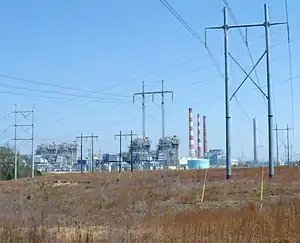| James M. Barry Electric Generating Plant | |
|---|---|
 The plant in 2009 | |
| Country |
|
| Location | Bucks, Alabama |
| Coordinates | 31°0′22″N 88°0′40″W / 31.00611°N 88.01111°W |
| Status | Operational |
| Commission date | Unit 1: February, 1954 Unit 2: July, 1954 Unit 3: July, 1959 Unit 4: July, 1959 Unit 5: October, 1971 Gas Units: May, 2000 |
| Owner(s) | Alabama Power Company |
| Thermal power station | |
| Primary fuel | Bituminous coal, natural gas |
| Turbine technology | Steam, Combined cycle Steam, Combined Cycle Combustion turbine |
| Cooling source | Mobile River |
| Power generation | |
| Nameplate capacity | 2,671 MW |
James M. Barry Electric Generating Plant, also known as Barry Steam Plant or Plant Barry is a coal- and natural gas-fired electrical generation facility in Bucks, Mobile County, Alabama, United States.[1] It lies on the west bank of the Mobile River, using it both for coal delivery as well as for cooling water. The plant was named for James M. Barry, President of Alabama Power Company from 1949 to 1952.[2] As of 2018, the plant has 9 units, seven of which are powered by gas and two which are powered by coal.[3]
Design and specification
The Barry Plant has two coal-fired units but originally had five coal-fired units, which came online in 1954–1971, with respective generating capacities of 138 MW, 137 MW, 249 MW, 362 MW, and 750 MW (year-around). Five natural gas-fired units, including three combined cycle combustion turbines (173 MWe each of winter capacity) and two combined cycle steam turbines (193 MWe each of winter capacity), were installed in 2000.[4]
Environmental impact
Air
A 2007 survey by the Washington, D.C.-based Environmental Integrity Project found that the Barry Plant ranked 25th of the top 30 mercury emitting power plants in the United States, releasing 711 pounds (323 kg) of mercury into the atmosphere annually. The plant ranked 28th for the amount of nitrogen oxides released into the atmosphere, with 24,000 tons released. Additionally, the survey found that the plant released a yearly total of 61,000 tons of sulfur dioxide and 11 million tons of carbon dioxide.[5][6] A company spokesman for Alabama Power, Michael Sznajderman, noted that scrubbers are being installed at all of the company's coal-fired plants, which will reduce emission levels in coming years.[6]
The James M. Barry Electric Generating Plant has a coal ash pond in a "hairpin crook of the Mobile River", which leaches heavy metals into the groundwater and into the river.[7] For this reason, the Mobile River was listed as the third most endangered river in America.[8]
Waste heat
The plant discharges all of its waste heat (about twice its electrical output) into the Mobile River.
References
- ↑ "Generating plants". Alabama Power. Archived from the original on September 17, 2010. Retrieved August 15, 2010.
- ↑ "Manuscript Collections". University of Alabama Libraries. University of Alabama. Archived from the original on December 15, 2012. Retrieved August 15, 2010.
- ↑ Adkins, 01/03/2018 | Jason (2018-01-03). "Collaboration and Innovation Drive Retrofit Success at Plant Barry". POWER Magazine. Retrieved 2019-07-18.
{{cite web}}: CS1 maint: numeric names: authors list (link) - ↑ "Existing Electric Generating Units in the United States, 2008" (Excel). Energy Information Administration, U.S. Department of Energy. 2008. Retrieved 2009-11-28.
- ↑ "Barry Power Plant". Asbestos.com, Mesothelioma Center. Retrieved August 15, 2010.
- 1 2 Spencer, Thomas (November 21, 2008). "Coal-fired plant in West Jefferson County puts more mercury in air than any other in nation". The Birmingham News. Archived from the original on June 8, 2011. Retrieved August 15, 2010.
- ↑ Renkl, Margaret (2022-05-09). "Opinion | On an Endangered River, Another Toxic Disaster Is Waiting to Happen". The New York Times. ISSN 0362-4331. Retrieved 2022-05-09.
- ↑ "Mobile River". Retrieved 2022-05-09.
External links
- Data on generation and fuel consumption from the Energy Information Administration Electricity Data Browser